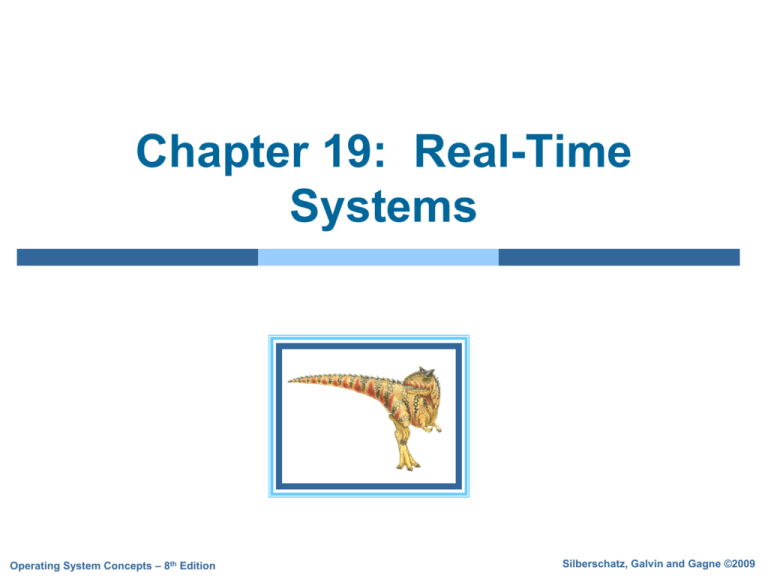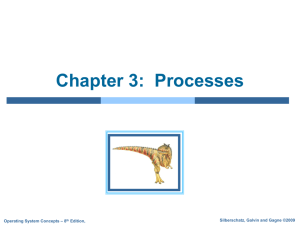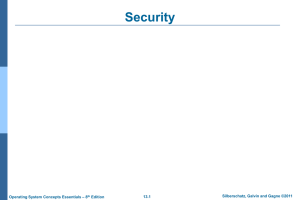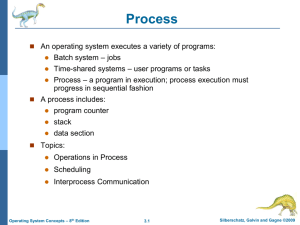ch19 - ASW Moodle
advertisement

Chapter 19: Real-Time Systems Operating System Concepts – 8th Edition Silberschatz, Galvin and Gagne ©2009 Chapter 19: Real-Time Systems System Characteristics Features of Real-Time Systems Implementing Real-Time Operating Systems Real-Time CPU Scheduling An Example: VxWorks 5.x Operating System Concepts – 8th Edition 19.2 Silberschatz, Galvin and Gagne ©2009 Objectives To explain the timing requirements of real-time systems To distinguish between hard and soft real-time systems To discuss the defining characteristics of real-time systems To describe scheduling algorithms for hard real-time systems Operating System Concepts – 8th Edition 19.3 Silberschatz, Galvin and Gagne ©2009 Overview of Real-Time Systems A real-time system requires that results be produced within a specified deadline period. An embedded system is a computing device that is part of a larger system (i.e., automobile, airliner). A safety-critical system is a real-time system with catastrophic results in case of failure. A hard real-time system guarantees that real-time tasks be completed within their required deadlines. A soft real-time system provides priority of real-time tasks over non real-time tasks. Operating System Concepts – 8th Edition 19.4 Silberschatz, Galvin and Gagne ©2009 System Characteristics Single purpose Small size Inexpensively mass-produced Specific timing requirements Operating System Concepts – 8th Edition 19.5 Silberschatz, Galvin and Gagne ©2009 System-on-a-Chip Many real-time systems are designed using system-on-a-chip (SOC) strategy SOC allows the CPU, memory, memory-management unit, and attached peripheral ports (i.e., USB) to be contained in a single integrated circuit Operating System Concepts – 8th Edition 19.6 Silberschatz, Galvin and Gagne ©2009 Bus-Oriented System Operating System Concepts – 8th Edition 19.7 Silberschatz, Galvin and Gagne ©2009 Features of Real-Time Kernels Most real-time systems do not provide the features found in a standard desktop system Reasons include Real-time systems are typically single-purpose Real-time systems often do not require interfacing with a user Features found in a desktop PC require more substantial hardware that what is typically available in a real-time system Operating System Concepts – 8th Edition 19.8 Silberschatz, Galvin and Gagne ©2009 Virtual Memory in Real-Time Systems Address translation may occur via: 1. Real-addressing mode where programs generate actual addresses 2. Relocation register mode 3. Implementing full virtual memory Operating System Concepts – 8th Edition 19.9 Silberschatz, Galvin and Gagne ©2009 Address Translation Operating System Concepts – 8th Edition 19.10 Silberschatz, Galvin and Gagne ©2009 Implementing Real-Time Systems In general, real-time operating systems must provide: 1. Preemptive, priority-based scheduling 2. Preemptive kernels 3. Latency must be minimized Operating System Concepts – 8th Edition 19.11 Silberschatz, Galvin and Gagne ©2009 Minimizing Latency Event latency is the amount of time from when an event occurs to when it is serviced. Operating System Concepts – 8th Edition 19.12 Silberschatz, Galvin and Gagne ©2009 Interrupt Latency Interrupt latency is the period of time from when an interrupt arrives at the CPU to when it is serviced Operating System Concepts – 8th Edition 19.13 Silberschatz, Galvin and Gagne ©2009 Dispatch Latency Dispatch latency is the amount of time required for the scheduler to stop one process and start another Operating System Concepts – 8th Edition 19.14 Silberschatz, Galvin and Gagne ©2009 Real-Time CPU Scheduling Periodic processes require the CPU at specified intervals (periods) p is the duration of the period d is the deadline by when the process must be serviced t is the processing time Operating System Concepts – 8th Edition 19.15 Silberschatz, Galvin and Gagne ©2009 Scheduling of tasks when P2 has a higher priority than P1 Operating System Concepts – 8th Edition 19.16 Silberschatz, Galvin and Gagne ©2009 Rate Montonic Scheduling A priority is assigned based on the inverse of its period Shorter periods = higher priority; Longer periods = lower priority P1 is assigned a higher priority than P2. Operating System Concepts – 8th Edition 19.17 Silberschatz, Galvin and Gagne ©2009 Missed Deadlines with Rate Monotonic Scheduling Operating System Concepts – 8th Edition 19.18 Silberschatz, Galvin and Gagne ©2009 Earliest Deadline First Scheduling Priorities are assigned according to deadlines: the earlier the deadline, the higher the priority; the later the deadline, the lower the priority Operating System Concepts – 8th Edition 19.19 Silberschatz, Galvin and Gagne ©2009 Proportional Share Scheduling T shares are allocated among all processes in the system An application receives N shares where N < T This ensures each application will receive N / T of the total processor time Operating System Concepts – 8th Edition 19.20 Silberschatz, Galvin and Gagne ©2009 Pthread Scheduling The Pthread API provides functions for managing real-time threads Pthreads defines two scheduling classes for real-time threads: 1. SCHED_FIFO - threads are scheduled using a FCFS strategy with a FIFO queue. There is no time-slicing for threads of equal priority 2. SCHED_RR - similar to SCHED_FIFO except time-slicing occurs for threads of equal priority Operating System Concepts – 8th Edition 19.21 Silberschatz, Galvin and Gagne ©2009 VxWorks 5.0 Operating System Concepts – 8th Edition 19.22 Silberschatz, Galvin and Gagne ©2009 Wind Microkernel The Wind microkernel provides support for the following: 1. Processes and threads 2. Preemptive and non-preemptive round-robin scheduling 3. Manages interrupts (with bounded interrupt and dispatch latency times) 4. Shared memory and message passing interprocess communication facilities Operating System Concepts – 8th Edition 19.23 Silberschatz, Galvin and Gagne ©2009 End of Chapter 19 Operating System Concepts – 8th Edition Silberschatz, Galvin and Gagne ©2009






